Miracinae
Mirax
Alejandro A. Valerio- Mirax brasiliensis Brues
- Mirax ectoedemiae (Rhower) Muesebeck
Note: this taxon list is still under construction. It does not yet contain all known Miracinae subgroups.
Introduction
The subfamily Miracinae is composed of solitary koinobiont-endoparasitic wasps which are known to attack the tiny leafmining caterpillars of the lepidopteran families Nepticulidae, Tischeriidae, Heliozelidae, Lyonetiidae and Gracillariidae (Maetô 1995, Memmott et al. 1994, Shaw and Huddleston 1991, Whitfield and Wagner 1991, Whitfield 1997). These wasps have been subjects of studies of their associations with symbiotic viruses (see below) and their roles in tropical food webs (Lewis et al. 2002). Mirax is one of the few braconid genera for which there appears to exist a fairly decent host record compilation: almost 50% of the described species have at least one host record associated with them, when compared with other biocontrol braconid genera such as Triraphis (=Rogas sensu lato), for witch less than 11% of the species have some kind of host record in the Neotropics (A. A. Valerio, unpublished data). This may, however, result from only the reared species in this group tending to be described.
One interesting aspect of these insects is the presence of polydnaviruses (PDVs) in their ovaries, only recently confirmed by Wharton and Sittertz-Bhatkar (2002). It is known that these PVDs are released by female wasps as maternal secretions from their reproductive organs during oviposition and that PDV gene expression acts to shut down or suppress the host defenses, allowing the wasp eggs to avoid encapsulation by the host (Stoltz 1993, Whitfield and Asgari 2003). The amazing discovery that the wasp/bracovirus relationship originated almost 74 million years ago has helped confirm how closely related the Miracinae are phylogenetically to the other PDV-bearing braconid wasp subfamilies, as suggested by both comparative morphology and DNA sequence data (Belshaw et al. 1998; Whitfield et al. 2002) (Fig. 3).

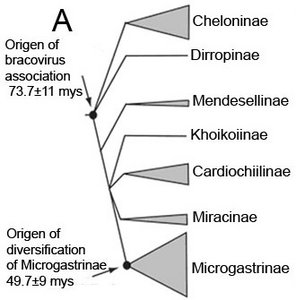
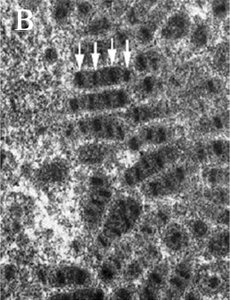
Figure 3. A. Summary of relationships among the bracovirus-bearing wasps indicating estimated times of origin of the virus-bearing clade. The area of the triangles roughly indicates estimated species richness at tip nodes; consult Whitfield and Asgari (2003) for further details. Figure modified after Whitfield and Asgari (2003), © Alejandro A. Valerio. B. Rod-shaped virions with nucleocapsids (indicated by arrows) from Mirax sp. 2. Figure modified after Wharton and Sittertz-Bhatkar (2002). Image © 2002 International Society of Hymenopterists.
Characteristics
The genus Mirax was first described by Haliday in 1834 with the following description:
“Maxillary palpi 4-, labial 3-jointed. Antenna 14-jointed. Eyes somewhat villose. Abdomen showing 7 segments above, 6 beneath, smooth, shining. Radius of the fore wing hardly inchoate, springing from the same point in the stigma as the 1st intercubital; two cubital areolets, the 2nd imperfectly separated from the radial. Terebra subexerted”.
The genus and the subfamily exhibit a very characteristic “Y” shaped structure formed by the first three metasomal terga (Fig 4), a reduced and distinct wing venation (Fig. 5A) in combination with a 14-segmented antenna and a non-cyclostome clypeus (Fig. 5B)

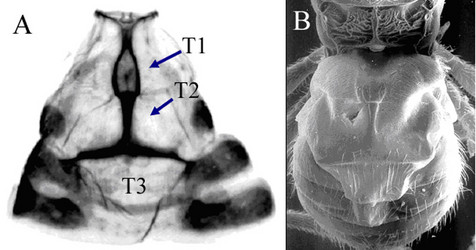
Figure 4. Metasomal terga of Mirax sp. after clarification with KOH (A) and their natural shape seen using a Scanning Electron Microscope (B). Images copyright© 2007 Alejandro A. Valerio
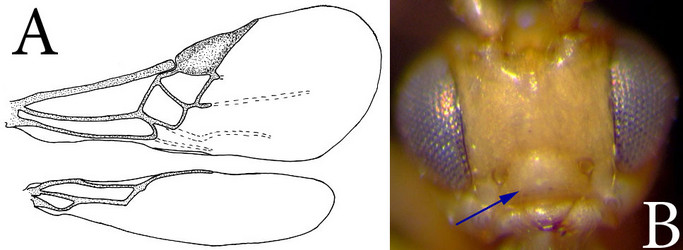
Figure 5. Wing venation of Mirax sp. (A) and non-cyclostome clypeus (arrow points at it) of M. brasiliensis Brues (B). Images copyright© 2007 Alejandro A. Valerio.
Classification
Over the years the genus Mirax has been placed within the braconid subfamilies Ichneutinae and Adeliinae, but it was not until van Achterberg (1983) that the taxonomic name Miracinae was used in the literature, which was followed by Papp (1987) and most authors afterwards. Many of the previous placements of the genus Mirax were done based only on the reduced wing venation (Fig. 5A) as well as on the absence of other characters diagnosing other known subfamilies of non-cyclostome braconids (e. g., metasoma forming a carapace in the subfamily Cheloninae).
At the genus level, currently only one genus is widely accepted (Mirax); however in a more recent taxonomic work, He et al. 2000, revived the use of the genus name Centistidea, using a different set of characters from the original description for its definition and diagnosis, but its validity has not been rigorously assessed on a broad geographic scale and the change has not been widely adopted. Nevertheless, some authors have referred to the potential existence of other genera - according to Whitfield (1997) and Shaw (2006) up to six genera world wide, at least one new for the Neotropics (Jenö Papp, person. com. 1999).
Phylogenetic Position of Miracinae
The subfamily Miracinae is included within the ‘microgastroid’ assemblage of braconid subfamilies; this assemblage of taxa basically represents the ‘Microgastri’ sensu Mason (1983) plus the subfamily Mendesellinae (Fig. 6). The Miracinae is the sister group of the subfamily Koinokhoinae, and both subfamilies are the most derived taxa of the assemblage based on the morphological analysis by Whitfield and Mason (1994). So far the subfamily Miracinae has been established to be a monophyletic group using morphological characters (Whitfield & Mason 1994).
References
Achterberg, C. 1993. Illustrated key to the subfamilies of the Braconidae (Hymenoptera: Ichneumonoidea. Zool. Verhand. 283: 1-189.
Belshaw, R., Fitton, M., Herniou, E., Gimeno, C. and D.L.J. Quicke. 1998. A phylogenetic reconstruction of the Ichneumonoidea (Hymenoptera) based on the D2 variable region of 28S ribosomal RNA. Systematic Entomology 23: 109-123.
Haliday, A.H. 1834. Essay on the classification of parasitic Hymenoptera, and c. Entomological Magazine 2(3): 230-231.
He, J., Chen, X. and Y. Ma. 2000. Hymenoptera Braconidae. Fauna Sinica Insecta 18: 322-324.
Lewis, O. T., J. Memmott, J. LaSalle, C. H. C. Lyal, C. Whitefoord and H. Charles J. Godfray. 2002. Structure of a diverse tropical forest insect-parasitoid community. Journal of Animal Ecology 71: 855-873.
Maetô, K. 1995. The genus Mirax (Hymenoptera, Braconidae, Miracinae) from Japan. Japanese Journal of Entomology 63(3): 649-656.
Mason, W.R.M. 1983. A new South African subfamily related to Cardiochilinae (Hymenoptera: Braconidae). Contributions of the American Entomological Institute 20: 49-62.
Memmott, J., Godfray, H.C.J. and I.D. Gauld. 1994. The structure of a tropical host-parasitoid community. Journal of Animal Ecology 63: 521-540.
Papp, J. 1987. Braconidae (Hymenoptera) from Korea, IX. Acta Zoologica Hungarica 33(3/4): 435-456.
Shaw, S.R. 2006. Braconidae. Pp 487-525. In: Hanson, P. and I. Gauld (eds.), Hymenoptera de la region tropical. Memoirs of the American Entomological Institute, Volume 77. Gainesville, Florida (USA), 994 p.
Shaw, M.R. and T. Huddleston. 1991. Classification and biology of braconid wasps. Handbooks of the identification of British insects 7: 1-126.
Stoltz, D.B. 1993. The polidnavirus life cicle, P p 167-187. In: Beckage, N.E., Thompson, S.N., and Federici, B.A. (Eds), Parasites and Patogens of Insects, Volume 1. Academic Press, N.Y.
Wharton, R.A. and H. Sittertz-Bhatkar. 2002. Polydna viruses in the genus Mirax Haliday (Hymenoptera: Braconidae). Journal of Hymenoptera Research 11: 358-365.
Whitfield, J.B. and W.R.M. Mason. 1994. Mendesellinae, a new subfamily of braconid wasps (Hymenoptera, Braconidae) with a review of relationships within the microgastroid assemblage. Systematic Entomology 19: 61-76.
Whitfield, J.B. and D.L. Wagner. 1991. Annotated key to the genera of Braconidae (Hymenoptera) attacking leafmining Lepidoptera in the Holartic region. Journal of Natural History 25: 733-754.
Whitfield, J.B. 1997. Subfamily Miracinae. Pp. 403-412. In: Wharton, R.A., Marsh, P.M. and M.J. Sharkey (eds.), Manual of the New World genera of the family Braconidae (Hymenoptera). Special publication of the International Society of Hymenopterists, No. 1.
Whitfield, J.B., Mardulyn, P., Austin, A.D. and M. Dowton. 2002. Phylogenetic relationships among microgastrine braconid wasp genera based on data from the 16S, COI and 28S genes and morphology. Systematic Entomology 27: 337-359.
Whitfield, J.B. and S. Asgari. 2003. Virus or not? Phylogenetics of polydnaviruses and their wasp carriers. Journal of Insect Physiology 49: 397-405.
Information on the Internet
Identification Guides
The manual for the New World Genera of family Braconidae (Wharton et al. 1997) can be used for the identification of genera. There are also online versions of these keys.
Title Illustrations

About This Page
Work on the Miracinae Tree of Life web page was supported by the Central American Institute for Biological Research and Conservation (CIBRC). The author wants to thank Jessica Diaz P. for her valuable comments during the development of this webpage.

Centralamerican Institute for Biological Research and Conservation (CIBRC), Costa Rica
Correspondence regarding this page should be directed to Alejandro A. Valerio at
Page copyright © 2007
All Rights Reserved.
- First online 11 May 2007
- Content changed 11 May 2007
Citing this page:
Valerio, Alejandro A. 2007. Miracinae . Mirax . Version 11 May 2007 (under construction). http://tolweb.org/Mirax/23453/2007.05.11 in The Tree of Life Web Project, http://tolweb.org/




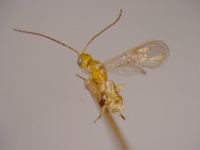
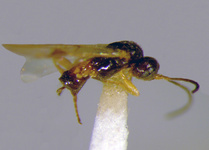




 Go to quick links
Go to quick search
Go to navigation for this section of the ToL site
Go to detailed links for the ToL site
Go to quick links
Go to quick search
Go to navigation for this section of the ToL site
Go to detailed links for the ToL site